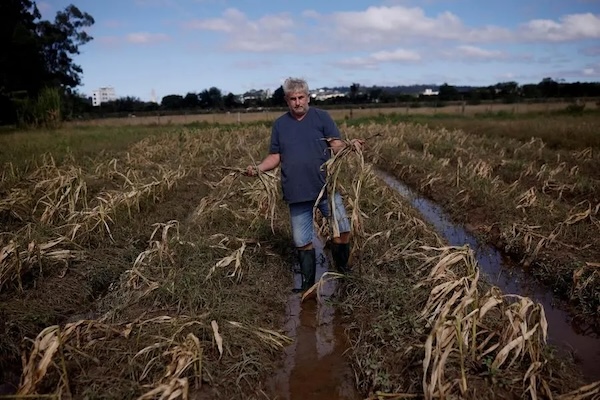Brazil’s farmers have a mess on their hands with massive flooding in the south and unseasonably hot, dry weather in south-central parts of the country. The weather extremes will impact both soybean and corn production this year, and the flooding is already creating major logistical headaches in the south. The flood waters have also swallowed up farm equipment and some crops in storage. Brazil’s livestock sector in the flooded south is also likely to experience some fallout.
Soybeans: Torrential rains in the southern part of Brazil have led to extensive flooding, particularly in Rio Grande do Sul. It’s estimated that as much as 3 to 4 feet of rain has fallen in southern Brazil now after another deluge struck this weekend. The full extent of the damage won’t be known until flood waters recede.
Before the latest round of rainfall this weekend, state agency Emater/RS said soybean losses in Rio Grande do Sul already ranged from 20% to 100% in areas not harvested yet. It was estimated that around a quarter of soybean fields in Rio Grande do Sul had yet to be harvested as of last Thursday, according to Safras & Mercado, putting some 5 million metric tons of soybeans at risk.
Soybeans in top production state Mato Grosso were impacted earlier in the season by lack of rainfall, which has already led to steep crop downgrades. In fact, Brazil crop agency CONAB has cut its soybean estimate in every monthly production report so far this year (for corn as well). They started off at 162 million metric tons but were down to 146 MMT by the April update, which came before the floods.
In the first forecast since the floods, CONAB has actually lifted its estimate to 147.685 MMT. However, the agency said it hasn’t been possible to get into fields and properly assess the damage yet due to high water levels. The agency also notes that future revisions will need to be made for both harvested and already stored grain in flooded areas. Notably, USDA in the most recent WASDE did reduce its outlook for Brazil soybeans but only by -1 MMT to 154 MMT
Corn: Brazil’s key “safrinha”, or second corn crop has been impacted by unseasonably hot and dry conditions starting in late April and on into May. Big production states of Mato Grosso, Mato Grosso do Sul, Goias, and Minas Gerais witnessed an early end to the rainy season, meaning crops were already facing a moisture deficit. That’s been followed by a hot, dry spell spanning the critical pollination and grain filling stages, particularly in Mato Grosso do Sul and northwestern Parana. Yields are likely to be impacted but it’s really too early to know how deep the losses might cut, especially if the heat dome remains stalled over the region.
The safrinha crop, which means “little harvest” in Portugese, is actually Brazil’s biggest, accounting for 70%-75% of the country’s total production. In 2023-24, Conab has it accounting for 77% of total estimated corn production. Second crop corn is planted right after soybean harvest, January – March, depending on the latitude. Harvest similarly varies, stretching from June to August depending on location. The safrinha crop tends to be the main competition for US corn exports in the second half of the year.
There is also expected to be some loss to corn crops in southern Brazil but again, the full extent of losses won’t be known until flood waters recede. It’s also worth noting that a lot of stored grain is expected to be lost from the flooding.
USDA in the May WASDE reduced its outlook for Brazil’s corn crop by -2 million MMT to an estimated 122 MMT. CONAB’s corn estimates have consistently been more conservative than the USDA. The Brazil agency’s initial estimate was only 119.40 MMT and has since fallen to 111.636 MMT in its most recent update (5/14). CONAB notes that second corn crop conditions are not uniform. While Mato Grosso’s crop is said to be in good shape, CONAB says the lack of rainfall in April caused symptoms of water stress in Mato Grosso do Sul, São Paulo, Minas Gerais, and part of Paraná.
Livestock: Rio Grande do Sul has experienced major disruptions to its network of meat processing plants, with two of its 10 plants still paralyzed, according to the Brazilian Animal Protein Association. The region is responsible for 11 percent of Brazil’s chicken meat production, of which it is the world’s largest exporter, and almost 20 percent of pork, of which it is the world’s fourth-largest exporter.
Logistics: The flooding in southern Brazil has caused extensive damage to infrastructure, while over half a million people have been evacuated. Hundreds of thousands have no electricity or fresh water and tens of thousands of homes have been destroyed. The agriculture sector in the region is facing widespread logistical issues amid damaged and washed-out roads, bridges, and railroads. This is also disrupting access to the port of Rio Grande. Meanwhile, flooding in the central part of the state has closed the ports of Pelotas and Porto Alegre, which both handle agricultural commodities. The three Rio Grande do Sul ports handled about 44.8 MMT in 2023, with the larger Rio Grande port accounting for at least 42.6 MMT according to port data. The Rio Grande port was the fifth-largest soybean exporter in 2023. Southern ag regions also likely face some labor shortages with so many people displaced.













